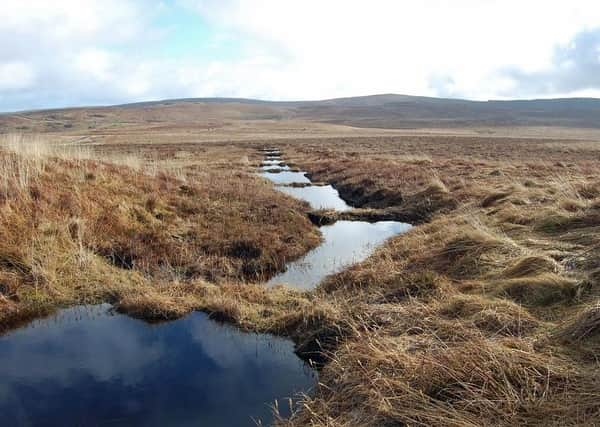RSPB: Peatland restoration is vital if NI is serious about a green recovery


Peatland covers approximately 12% of the land area of Northern Ireland, but 86% of our peatlands have been damaged by pressures including drainage, overgrazing, afforestation, burning and extraction in lowland areas. As a result, many of our peatlands are net emitters of greenhouse gases.
Despite the urgent need to restore this habitat, only as little as 1% has been restored in the past 30 years.
Advertisement
Advertisement
In the past week, Prime Minister Boris Johnson set out plans for the UK to cut greenhouse gas emissions further and faster than any other major economy in the next decade – setting a target of a 68% reduction in annual carbon emissions. Restoring peatlands must be central in efforts to achieve a green recovery, delivering benefits to the economy, nature and climate.
As well as being crucial in mitigating climate change, peatlands also play a vital role in supporting unique plants and rare wildlife, improve our water quality, and upland peatlands also help prevent flooding. Drain blocking on the Garron Plateau in County Antrim has restored large areas of blanket bog which will avoid the emission of 1,992 tonnes of CO2 equivalent every year.
However, in Northern Ireland over three quarters are degraded, while as little as 1% has been restored over the last 30 years. The RSPB’s new analysis shows that the poor condition of our peatlands results in the release of carbon equivalent to 5% of total UK greenhouse gas emissions every year – more annual emissions than all of the HGVs on UK roads.
As delegates join together to discuss peatland restoration across the UK at the online IUCN (International Union for Conservation of Nature) UK Peatland Conference, Jonathan Bell, RSPB NI Head of Land and Sea Policy, points out that Northern Ireland has a long way to go to restore our peatlands to a healthy condition:
Advertisement
Advertisement
“Peatland covers approximately 12% of the land area of Northern Ireland, but only 14% of these are classified as in good condition. Due to a range of pressures such as drainage, overgrazing, afforestation, burning and extraction in lowland areas, only as little as 1% of NI’s peatland has been restored in the past 30 years.
“Through working in partnership in some of our most treasured landscapes, we’ve seen the benefits that peatland restoration can bring for climate, nature and people.
“This vital work must be scaled up to ensure that these habitats can play an important role in addressing the nature and climate emergencies and to secure a green recovery. To do this, we need a peatland strategy which commits to an ambitious programme of restoration in Northern Ireland.”
Other nations have recognised the need to fund peatland restoration.
Advertisement
Advertisement
For example, Scotland has committed £250 million over the course of 10 years, the Republic of Ireland recently invested £108 million and Wales has recently committed to increased funding.
Peatland restoration is a devolved issue and RSPB NI is calling on the Northern Ireland Executive to act urgently to set out clear restoration targets and allocate substantial funding for restoration and rewetting of the habitat to halt greenhouse gas emissions in line with achieving net zero targets. Across the UK, the RSPB is calling for an end to destructive practices such as the continued extraction and sale of peat, the planting of trees on peatland and the burning of vegetation on peatlands.
Martin Harper, RSPB Director of Global Conservation, said: “Peatlands are an incredibly important habitat in the UK both for wildlife and for storing carbon. Unfortunately, our analysis shows that they are also in a poor condition and they are haemorrhaging carbon into the atmosphere, instead of storing it safely in the ground. We urgently need to be doing everything we can to restore our peatlands to good health.
“If our peatlands are not restored, they will emit twice as much carbon as would be captured by tree planting in the Committee on Climate Change’s UK forestry targets for 2050. In other words, by continuing to neglect and damage our peat bogs, any carbon benefits of these new woodlands will be cancelled out. To meaningfully harness the power of nature to tackle climate change, we must restore and protect our peatlands.”
Advertisement
Advertisement
Jonathan Bell added: “When peat is restored, water tables rise, bog plants colonise, and in due course, bog wildlife arrives. In good condition, the peat returns to its role as a massive carbon store; sequestering carbon and improving water quality.
“The poor condition of many of our peatlands in Northern Ireland means that they are emitting greenhouse gases into the atmosphere, undermining our climate ambitions and doing little for people or nature.
“The inclusion of emissions from degraded peatland could add around 9% to Northern Ireland’s total emissions in their current state
“Peatland restoration would also bring job creation. RSPB NI’s recently-launched Green Recovery five-point plan includes a call for the establishment of a green recovery fund to deliver this type of restoration at scale.”
Advertisement
Advertisement
Peatland restoration is vital to meeting climate ambitions. A new story map highlights how drain blocking on the Garron Plateau in County Antrim has restored large areas of blanket bog which will avoid the emission of 1,992 tonnes of CO2 equivalent every year.
See the analysis and the interactive RSPB story map here: https://arcg.is/0PT8qy